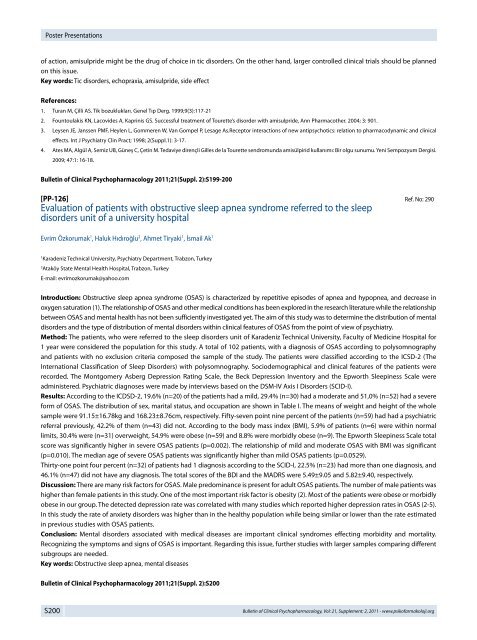SYMPOSIA
SYMPOSIA
SYMPOSIA
Create successful ePaper yourself
Turn your PDF publications into a flip-book with our unique Google optimized e-Paper software.
Poster Presentations<br />
of action, amisulpride might be the drug of choice in tic disorders. On the other hand, larger controlled clinical trials should be planned<br />
on this issue.<br />
Key words: Tic disorders, echopraxia, amisulpride, side effect<br />
References:<br />
1. Turan M, Çilli AS. Tik bozuklukları. Genel Tıp Derg. 1999;9(3):117-21<br />
2. Fountoulakis KN, Lacovides A, Kaprinis GS. Successful treatment of Tourette’s disorder with amisulpride, Ann Pharmacother. 2004; 3: 901.<br />
3. Leysen JE, Janssen PMF, Heylen L, Gommeren W, Van Gompel P, Lesage As.Receptor interactions of new antipsychotics: relation to pharmacodynamic and clinical<br />
effects. Int J Psychiatry Clin Pract; 1998; 2(Suppl.1): 3-17.<br />
4. Ates MA, Algül A, Semiz UB, Güneş C, Çetin M. Tedaviye dirençli Gilles de la Tourette sendromunda amisülpirid kullanımı: Bir olgu sunumu. Yeni Sempozyum Dergisi.<br />
2009; 47:1: 16-18.<br />
Bulletin of Clinical Psychopharmacology 2011;21(Suppl. 2):S199-200<br />
[PP-126] Ref. No: 290<br />
Evaluation of patients with obstructive sleep apnea syndrome referred to the sleep<br />
disorders unit of a university hospital<br />
Evrim Özkorumak 1 , Haluk Hıdıroğlu 2 , Ahmet Tiryaki 1 , İsmail Ak 1<br />
1 Karadeniz Technical University, Psychiatry Department, Trabzon, Turkey<br />
2 Ataköy State Mental Health Hospital, Trabzon, Turkey<br />
E-mail: evrimozkorumak@yahoo.com<br />
Introduction: Obstructive sleep apnea syndrome (OSAS) is characterized by repetitive episodes of apnea and hypopnea, and decrease in<br />
oxygen saturation (1). The relationship of OSAS and other medical conditions has been explored in the research literature while the relationship<br />
between OSAS and mental health has not been sufficiently investigated yet. The aim of this study was to determine the distribution of mental<br />
disorders and the type of distribution of mental disorders within clinical features of OSAS from the point of view of psychiatry.<br />
Method: The patients, who were referred to the sleep disorders unit of Karadeniz Technical University, Faculty of Medicine Hospital for<br />
1 year were considered the population for this study. A total of 102 patients, with a diagnosis of OSAS according to polysomnography<br />
and patients with no exclusion criteria composed the sample of the study. The patients were classified according to the ICSD-2 (The<br />
International Classification of Sleep Disorders) with polysomnography. Sociodemographical and clinical features of the patients were<br />
recorded. The Montgomery Asberg Depression Rating Scale, the Beck Depression Inventory and the Epworth Sleepiness Scale were<br />
administered. Psychiatric diagnoses were made by interviews based on the DSM-IV Axis I Disorders (SCID-I).<br />
Results: According to the ICDSD-2, 19.6% (n=20) of the patients had a mild, 29.4% (n=30) had a moderate and 51,0% (n=52) had a severe<br />
form of OSAS. The distribution of sex, marital status, and occupation are shown in Table I. The means of weight and height of the whole<br />
sample were 91.15±16.78kg and 168.23±8.76cm, respectively. Fifty-seven point nine percent of the patients (n=59) had had a psychiatric<br />
referral previously, 42.2% of them (n=43) did not. According to the body mass index (BMI), 5.9% of patients (n=6) were within normal<br />
limits, 30.4% were (n=31) overweight, 54.9% were obese (n=59) and 8.8% were morbidly obese (n=9). The Epworth Sleepiness Scale total<br />
score was significantly higher in severe OSAS patients (p=0.002). The relationship of mild and moderate OSAS with BMI was significant<br />
(p=0.010). The median age of severe OSAS patients was significantly higher than mild OSAS patients (p=0.0529).<br />
Thirty-one point four percent (n=32) of patients had 1 diagnosis according to the SCID-I, 22.5% (n=23) had more than one diagnosis, and<br />
46.1% (n=47) did not have any diagnosis. The total scores of the BDI and the MADRS were 5.49±9.05 and 5.82±9.40, respectively.<br />
Discussion: There are many risk factors for OSAS. Male predominance is present for adult OSAS patients. The number of male patients was<br />
higher than female patients in this study. One of the most important risk factor is obesity (2). Most of the patients were obese or morbidly<br />
obese in our group. The detected depression rate was correlated with many studies which reported higher depression rates in OSAS (2-5).<br />
In this study the rate of anxiety disorders was higher than in the healthy population while being similar or lower than the rate estimated<br />
in previous studies with OSAS patients.<br />
Conclusion: Mental disorders associated with medical diseases are important clinical syndromes effecting morbidity and mortality.<br />
Recognizing the symptoms and signs of OSAS is important. Regarding this issue, further studies with larger samples comparing different<br />
subgroups are needed.<br />
Key words: Obstructive sleep apnea, mental diseases<br />
Bulletin of Clinical Psychopharmacology 2011;21(Suppl. 2):S200<br />
S200 Bulletin of Clinical Psychopharmacology, Vol: 21, Supplement: 2, 2011 - www.psikofarmakoloji.org



